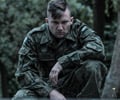David Kinchin, author and expert on PTSD sheds light on the invisible injury that continues to haunt many who have experienced a significant traumatic event.
Trauma is one of the mutest words with innumerable emotional interpretations. The nature of trauma is complex and the psychological impact runs deep that sometimes one may not even remember the cause of the pain inflicted but continue to suffer its symptoms. However David Kinchin, author of ‘Supporting Children with Post Traumatic Stress Disorder’ (2001), ‘Post Traumatic Stress Disorder, the Invisible Injury’ (2005), ‘A Guide to Psychological Debriefing’ (2007) to name a few, assures that help is at hand. He also wrote the course material for ‘Certificate in Living and Working with Post Traumatic Stress Disorder (PTSD)’, a distant learning programme to help PTSD victims and aspiring counsellors. Kinchin himself a victim of the condition has now become the leading expert of PTSD (Post Traumatic Stress Disorder) in UK and around the world. He shares his understanding of PTSD experiences with Medindia.
Q. When you conduct seminars on PTSD, what are the general concerns of people? What kind of people or group participate the most during such programmes, including the people who sign up for the PTSD Distant Learning Programme?A. Over the years I have conducted a wide variety of different courses and seminars, workshops and training days on PTSD. They have ranged from an hour long session, to courses which span four days!
You can imagine that covers a wide variety of different needs in delegates who attend. Some simply want information about the illness which is affecting a loved one. Some are in positions of responsibility and wish to know how to deal with PTSD cases. Some are medical staff in emergency units who want to know how to react to those who have been traumatised but who have yet to be diagnosed as suffering from PTSD. The longer course is usually about ‘Emotional Decompression’ which is more commonly known as ‘Psychological Debriefing’. These courses are usually for peer groups or counsellor groups who wish to train as a first line of attack against PTSD and wish to do the ‘defusing’ or ‘debriefing’ of those who have been exposed to trauma in whatever guise it comes in.
I enjoy the wide variety of courses and training I have been able to offer, and I am constantly thinking of new ways to present the material.
The types of delegates vary unbelievably. The partners of PTSD sufferers are perhaps the most rewarding as they bring so much material (just like case studies) to the course. Of course, confidentiality is the key to all of these courses, and what is said in the room during the course stays in that room. That is the contract which every delegate agrees to at the start.
Q. You have written the course material for ‘Certificate in Living And Working With Post Traumatic Stress Disorder (PTSD)’, what are the criteria you consider before you validate a person as eligible for a programme on treating or counselling PTSD victims?
A way of observing the effect the course is having on candidates is that I am the only tutor at present. I am able to monitor the progress each student is making, and offer different options for assignments depending upon who they are and what they are. Hence, although it is just one course, there are a variety of paths through the course which are tailored to suit people’s needs. So far, we have only turned a handful of people away from the course with the suggestion that they are not quite ready for this studying – yet!
Q. Symptoms of PTSD could be a result of any form of violence, not solely war or bullying. Besides it is easier to recognise symptoms in another person, but how is it possible to identify the symptoms in one self?
A. PTSD can result from any form of trauma. It doesn’t have to be violence. A car crash for example! A badly managed delivery of a baby or a poor medical procedure can result in PTSD. We have to remember what a broad base PTSD sufferers come from.
When looking at oneself, it is important to look for changes. These have to follow an exposure to a trauma or life threatening event. For example, the extrovert might become very shy and withdrawn (the opposite also is true). The very sober person takes to drinking. The person who sleeps well suddenly is unable to sleep and gain any real quality of rest – they wake up feeling exhausted. Dreams become nightmares and often repeat the same scenario in that dream. A person may develop a shake which they are unable to stop. They may resort to ‘recreational drugs’ to help them cope with everyday life. Mostly, people are unable to cope with everyday living. Their life just falls apart.
Q. Do you think people with PTSD are potentially harmful? If yes, how and to whom?
A. Without doubt, those with PTSD can become harmful, both to themselves and to others. They may be at risk of suicide for example. They may start beating their partner or children. They may turn to crime. Sometimes the level of violence within their life is dictated by the degree of violence exhibited in the trauma which affected them. Soldiers are commonly accused of wife beating after they have suffered a trauma.
Sometimes PTSD victims turn to self abuse. They may self harm. Women and girls may have such low self esteem that they turn to prostitution or even give away free sex to strangers. They hold themselves in such low worth.
PTSD sufferers can also turn to crime. They may steal or rob. Sometimes they claim they don’t realise what they are doing. The jury is still out on that one.
Q. Are there chances of PTSD victims imitating the behaviour of their offenders, meaning inflict the same pain on another human being, especially the ones dependent on them?
A. This is perfectly possible, but I don’t recall any direct cases of this myself.
Q. What would you suggest to the people who are in close contact with PTSD victims?
A. The two golden rules:
1. Watch for changes in a person’s character (as already mentioned). These sudden changes which are out of character can be a vital sign that something is wrong.
2. When PTSD is suspected, get professional help as swiftly as possible. It is almost impossible to deal with PTSD on your own.
If you are regularly dealing with PTSD cases then you must take safeguards for your own welfare. You must have regular ‘supervision’ sessions with a counsellor who is trained in supporting others who are caring for people. In UK it is compulsory that all counsellors have regular ‘supervision sessions’ with a counsellor during which time they can discuss anything which has particularly distressed or worried them. It is important not to take these traumas home and cause your family to suffer. Those who work frequently with PTSD cases must have even more regular supervision – at least every month.
Q. Stress and depression are becoming common, so how is the stress and depression of PTSD more of a concern than other forms?
A. Stress and depression are factors of everyday life it would appear. Many people have stressful occupations in the 21st Century and not coping with the stresses can lead to depression. There are also cases of clinical depression which come about through chemical changes within our body.
I’m not sure you can say that stress and depression within PTSD is MORE of a concern than other forms. I think they all have equal merit. It is just that the stresses and depression within PTSD can be treated in a number of ways, and in unison with the symptoms of PTSD. It is easy to get caught up in a discussion about which is the most important form of each illness. For me, they are all equal. Just because PTSD is my speciality, that doesn’t mean I see it in everyone. For example, the symptoms of bereavement are almost identical to the symptoms of PTSD, but you can usually trace the origins to either a death, or a trauma.
Q. Since the causes for PTSD are different and the age factor is also to be considered, what are the different treatments available?
A. Officially, in UK, there are just two recognised treatments of PTSD which the state will pay for within the National Health Service. I do take issue with this myself, but that is how things stand at the moment. The two treatments are CBT (Cognitive Behavioural Therapy) and EMDR (Eye-movement Desensitising and Reprocessing). Both are a bit of a mouthful. I have been on the receiving ends of both treatments. You need to be suitably qualified to administer either treatment to a client. I will not bore you with the details of these processes as both are well documented on the Internet and in Text books.
I feel very strongly that there is also a place for the ‘talking therapies’ that is ‘counselling’. A counsellor who is trained to counsel those who have been traumatised can actually work wonders over the passage of time. The trouble is that far too many counsellors are strict about delivering a one hour session about once a week for six weeks, and then think that is the end of things. For a start, I am not a fan of the one hour session. Sometimes a client might be right in the middle of telling their story, and the hour is up! What can you do? You can’t stop them in the middle. They have to be allowed to reach a safe place within that story. At the other extreme it may be that a client really is not in the mood, and so you draw a session to a close after only twenty minutes! That makes sense to me. However, I know that many counsellors would see that as a failure. I just see it as common sense.
You cannot counsel a PTSD client in just six sessions. It really isn’t possible. It takes many more sessions than that. This can sometimes lead to the counsellor ‘taking advantage’ of the situation, and milking the client for hours and hours – earning fees all the time. Counsellors who specialise in trauma and PTSD need to be a special breed of counsellor – those who are prepared to be flexible.
Q. Please share your experiences with children with PTSD.
A. Some of my most significant dealings with children who suffered from PTSD were experiences while my wife and I fostered children within our own family setting. These children lived with us 24/7 and we got to know them inside out.
What really struck us were the ‘triggers’ which would spark off unusual behaviour. The doorbell chiming would cause one boy to run and hide under the piano, in fear of whoever was visiting us. Another child would go and hide in the garden whenever he soiled his nappy – because his step father had beaten him with a cane whenever he did this in his home. This was the step-father’s idea of ‘potty training’ in the family, and it left scars which took many years to heal.
Children can draw pictures about their trauma. They usually do this far better than either talking or writing about it. Pictures work, but you have to learn to understand the pictures, and not jump to conclusions. Allow the child to talk about the picture if they feel they are able to do so. I remember one child who drew a picture of a crashed bus, the vehicle was upside down, and bodies were going in all directions within the body of the bus. His trauma was that his brother had been killed in such a bus crash. However, this bus crash took place before the brother was even born! That struck me as quite staggering that the trauma could be passed down the family in this way.
I could tell you many more stories – some of them great success stories of children who overcame their trauma and went on to pass educational exams, get married and raise a family of their own. It is wonderful when that happens and they are no longer tied to the past.
Q. In India, ‘ragging in colleges’ is more intense than ‘bullying in school’, many students have been victims of brutality by their seniors or peers. The legal intervention has considerably reduced ragging in colleges; however when students return to their institution, it’s definitely not easy for the victim to participate or perform like before, so what measures would you suggest that an educational institution should take to ensure victims re-engage in everyday activities without considerable apprehension?
A. You really are asking the sixty-four thousand dollar question here! I don’t really know. This is beyond my area of expertise. I do have a degree in Education Studies, and am a qualified teacher, but that still doesn’t give me any golden answer for you to this question. We do live in a world where ‘ragging’ or ‘sledging’ is an accepted way of life in some quarters. I know that international cricket players are renowned for doing this on the field of play in an attempt to upset the opposing players. Basically, you have to make rules outlawing the behaviour for happening. It isn’t very easy to police though.
Q. How do you safeguard yourself from PTSD while listening to traumatic incidents?
A. I try to get involved with the emotions of the client, to share an empathic bond with them. That is perhaps easier for me to achieve as the client usually has read one of my books and so knows I have suffered from PTSD myself – there is a trauma bond between us. However, I know this can be a dangerous game to play, so I have wonderful ‘supervisors’ to fall back on and to talk through any issues I may have after dealing with traumas.
Even with the supervision and the shared views of another vastly experienced counsellor, some of the experience does stick with me, and as a result I suspect that my own health has suffered – my wife would say so anyway! At the moment the consultants have diagnosed me as suffering with Short Fibre Neuropathy (SFN) which leaves me with nagging pains (mostly in my limbs) which require daily doses of morphine and ketamine to cope with the pain they produce. In short, the messages from my nerves to my brain have been scrambled and I constantly get pain messages even though there is nothing physically wrong with my legs. One school of thought is that the rushes of chemicals within the body which are brought about by the ‘flight or fight’ phenomenon have ‘burned’ some of my nerves to result in this disorder.
If that is so, then the damage is done. But had I not been attacked when I was a police officer, I would not have developed an interest in PTSD. Had I not developed that interest, I would not have flown to far away countries to deliver courses and lectures on the subject and I would not have written the books and plays and articles which I have written and which others say have been of use to them. So where do you start with the “what ifs” in life?
I still get a buzz out of sharing with clients and even going a little way in helping people to cope and to live with their symptoms, and if they actually get better, then that is the icing on the cake for me.
David Kinchin’s traumatic incident changed the course of his life to inspire and show people that there is a way out. And his dedication is extended with the hope, in his own words, “to improve the lot of those who are still suffering from Post Traumatic Stress Disorder – a disorder which some medical people still do not fully recognise as existing!”
Source-Medindia















